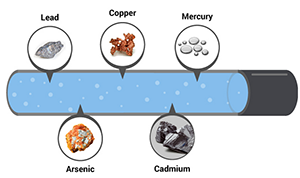The test stripe system has great potential in the field of monitoring contamination in industrial wastewater. It`s a fast and easy available system for qualitative control of several heavy metals.
 |
Heavy metals are significant environmental pollutants and their toxicity is a problem of increasing significance for ecological, evolutionary, nutritional and environmental reasons. The most commonly found heavy metals in water include cadmium, mercury, lead, arsenic, chromium, nickel, and zinc, all of which cause risks for human health and the environment. |
Effects of heavy metals on humans
Heavy metal toxicity can lower energy levels and damage the functioning of the brain, lungs, kidney, liver, blood composition and other important organs. Long-term exposure can lead to gradually progressing physical, muscular, and neurological degenerative processes that imitate diseases such as multiple sclerosis, Parkinson's disease, Alzheimer's disease and muscular dystrophy.
• Exposure of lead can cause loss of appetite, headache, hypertension, abdominal pain, renal dysfunction, fatigue, sleeplessness, arthritis, hallucinations and vertigo. Acute exposure mainly occurs in the place of work and in some manufacturing industries which make use of lead. Chronic exposure of lead can result in mental retardation, birth defects, psychosis, autism, allergies, dyslexia, weight loss, hyperactivity, paralysis, muscular weakness, brain damage, kidney damage and may even cause death.
• Exposure to elevated levels of metallic, organic and inorganic mercury can damage the brain, kidneys and the developing fetus. EPA has declared mercuric chloride and methyl mercury to be highly carcinogenic.
• Cadmium is highly toxic to the kidney and it accumulates in the proximal tubular cells in higher concentrations. Cadmium can cause bone mineralization either through bone damage or by renal dysfunction.
• Excessive amounts of nickel can be mildly toxic. Long term exposure can cause decreased body weight, heart and liver damage and skin irritation.
Monitoring of heavy metals
Rapid and high precision detection of toxic metal ions is one of the chief requirements today to combat environment pollution. Lateral flow test devices are powerful tools for on-site screening, and have attracted increasing attention in clinical diagnosis because of their simplicity, portability, long-term stability, and low cost.
Gold nanoparticles (GNP) play a key role in developing lateral flow assay. Due to the high extinction coefficients and distance-dependent optical properties, some scientists constructed lateral flow test by preparation of antibody-linked gold nanoparticles (AuNP) to make easy-to-use tests for metal ions such as lead, uranium, and copper. Creative Diagnostic offers CDIATM Colloidal Gold Test Cassettes which are an easy, safe, and economical way to test for the presence of lead, cadmium, mercury and other heavy metals. There is no need to order expensive tests or equipment. In a comparison with colloidal gold, the fluorescence probes offer potential advantages of high sensitivity and quantitative capabilities. The CDIATM Immunofluorescence Test Strips are quantitative and rapid lateral flow assays designed to detect lead, cadmium, mercury with lower LODs. Moreover, the test strips demonstrate excellent anti-interference capability, detection, and production reproducibility, long-term storage stability, and real water sample applicability.
Sources:
1. Nagajyoti P C, Lee K D, Sreekanth T V M. Heavy metals, occurrence and toxicity for plants: a review. Environ Chem Lett. 2010: 8(3), 199–216.
2. Lambert M, Leven B A, Green R M. New methods of cleaning up heavy metal in soils and water; Environmental science and technology briefs for citizens; Manhattan, KS: Kansas State University; 2000.
3. Monisha J, Tenzin T, Naresh A, Blessy B. M, and Krishnamurthy N. B. Toxicity, mechanism and health effects of some heavy metals. Interdiscip Toxicol, 2014: 7(2): 60–72.
4. Cheng N, Xu Y C, Huang K l, Chen Y T, Yang Z S, Luo Y B, Xu W T. One-step competitive lateral flow biosensor running on an independent quantification system for smart phones based in-situ detection of trace Hg (II) in tap water. Food Chemistry, 2017, 214: 169-175.
